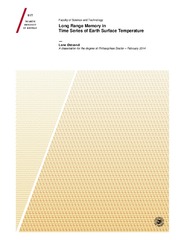Long Range Memory in Time Series of Earth Surface Temperature
Permanent lenke
https://hdl.handle.net/10037/6391Åpne
Thesis introduction (PDF)
K. Rypdal, L. Østvand and M. Rypdal: 'Long-range memory in Earth’s surface temperature on time scales from months to centuries', Journal of Geophysical Research: Atmospheres Volume 118, Issue 13, pages 7046–7062, 16 July 2013 (PDF)
L. Østvand, K. Rypdal and M. Rypdal: 'Statistical significance of rising and oscillatory trends in global ocean and land temperature in the past 160 years' (manuscript). A more recent version of this article is available in Munin at http://hdl.handle.net/10037/6786 (PDF)
L. Østvand, T. Nilsen, K. Rypdal, D. Divine and M. Rypdal: 'Long-Range Memory in Millennium-Long ESM and AOGCM Experiments' (manuscript). Later published in Earth Syst. Dynam., 5, 295–308, 2014, and available in Munin at http://hdl.handle.net/10037/6793 (PDF)
Entire thesis in one comprehensive file (PDF)
Dato
2014-05-23Type
Doctoral thesisDoktorgradsavhandling
Forfatter
Østvand, LeneSammendrag
Long-range memory (LRM) has been found in numerous natural data records, both in geophysics and other fields. In this thesis LRM in surface temperature time series is studied, and comparison with short-range memory (SRM) models performed.
Trends are important in climate studies, but the trend definition is ambiguous. Two different approaches are included here: the trend described as a function with parameters estimated from the data, and a response model to external forcing. The most commonly used trend function is the linear trend, often used as a measure of anthropogenic effects on global warming. The significance of the trend is dependent on the noise model assumed to describe the data, and here AR(1) and fractional Gaussian noise (fGn) are used.
Some methods for investigating SRM and LRM are described and applied to some selected examples. Comparison of SRM and LRM models is also included.
The thesis also includes a literature review. In the scientific literature mostly local temperature records have been analysed with regards to LRM. Global and hemispheric temperature means are far less studied, so this has been the main focus in this thesis. Three papers are included where the LRM properties of local and global instrumental records, temperature reconstructions and simulated temperature from climate model experiments are studied. In Paper I and II, a trend analysis is also performed.
The overall conclusion that can be drawn from the present work is that long-range persistence on time scales from years to centuries is ubiquitous in observed Earth surface temperature records, and that similar persistence is present in the most advanced climate models to date. This persistence weakens the significance of observed temperature trends, but not enough to render the rising temperature trends throughout the last century statistically insignificant.
Forlag
UiT Norges arktiske universitetUiT The Arctic University of Norway
Metadata
Vis full innførselSamlinger
Copyright 2014 The Author(s)
Følgende lisensfil er knyttet til denne innførselen:


 English
English norsk
norsk
